The 2011 MacBook Air (11 & 13-inch): Thoroughly Reviewed
by Anand Lal Shimpi on July 28, 2011 3:25 AM EST- Posted in
- Apple
- Mac
- Intel
- Sandy Bridge
- MacBook Air
- Laptops
CPU Performance: A Huge Upgrade
I've got an expanded test suite here courtesy of the testing I did for our Lion review. As I mentioned in our Lion review, performance hasn't changed between Snow Leopard and Lion for the most part so the older data in these benchmarks is still quite valid.
Adobe Photoshop CS4
The old Air was not very good for those doing a lot of photo work. You could manage, and I definitely did, but it was painful. The story is completely different with the new MacBook Air however.
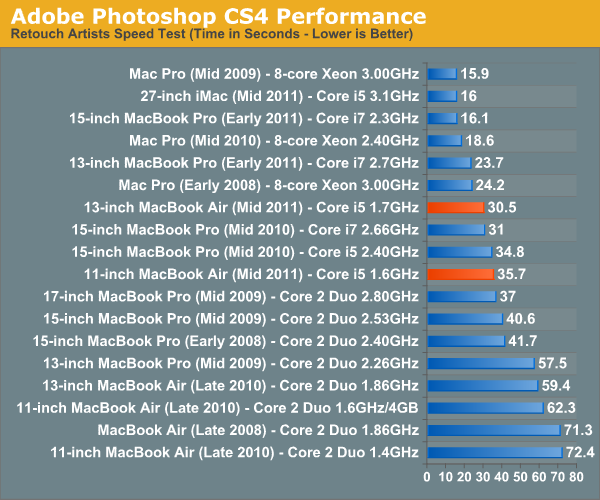
While the 2011 Macbook Pro is still considerably faster, completing our CS4 test in just over half the time as the 13-inch Air, these machines are competitive with last year's MBP. Remember the 2010 MacBook Pro only had two Arrandale cores and these Airs have lower clocked, but higher performing Sandy Bridge cores. Part of the performance advantage is the integrated SSD, whereas those older Macs didn't come with one by default. But most of the time these chips are running near their max turbo frequencies under load, which really helps narrow the performance gap between them and their 2010 professional counterparts.
If you have anything older than a 2010 MacBook Pro, these new Airs will actually be an upgrade for you.
Cinebench: Single & Multithreaded Performance
The old Air just wasn't that great of a performer. They were good enough if you didn't do much with your machine, but for those who lived on the bleeding edge they performed like a 3 year old MacBook Pro.
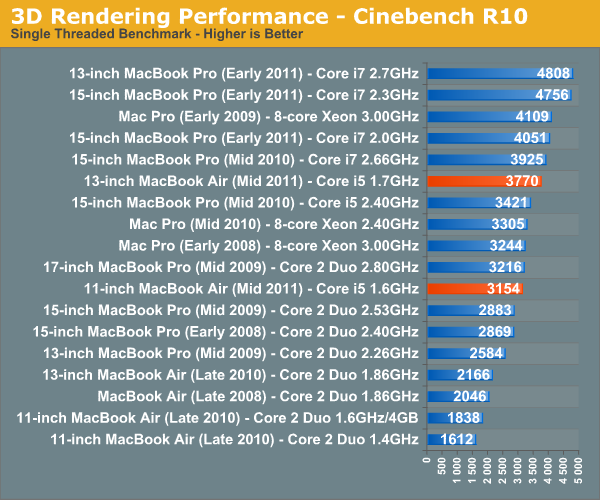
Single threaded performance on the new Air is much better than before thanks to turbo boost. The 11-inch MBA is 71% faster than the upgraded 11 from last year, that's more than noticeable in real world usage. The 13-inch MacBook Air enjoys a similar advantage over its predecessor.

Where things get even more ridiculous is in multithreaded performance:
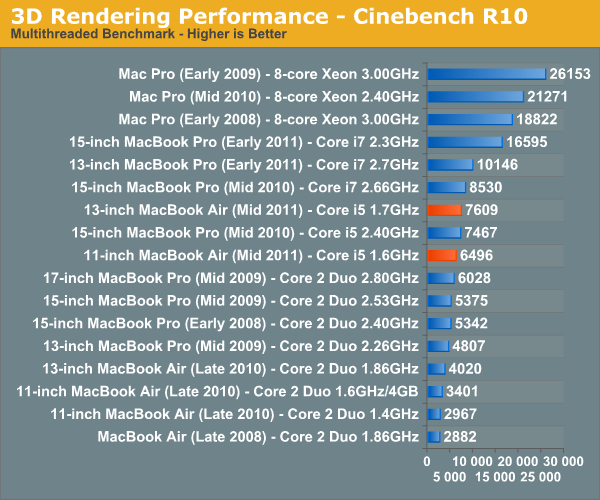
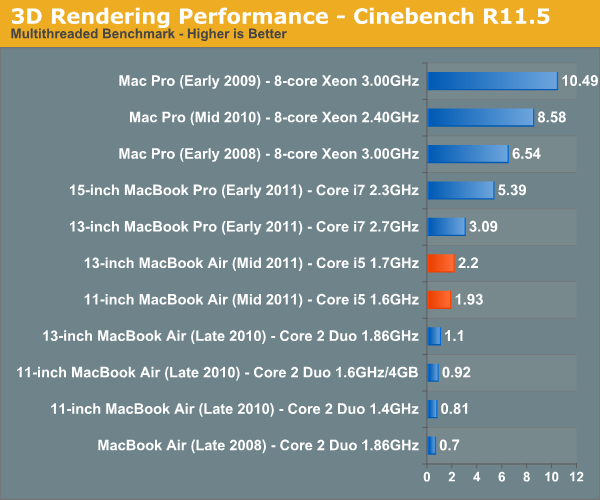
The single threaded performance of the new 11-inch MacBook Air is actually higher than the multithread performance of last year's model. Thanks to Hyper Threading and better performance per core you get around twice the performance of last year's models. Again the Air still isn't as good as the new quad-core MacBook Pros, but if you've got a machine from 2008 the new 13-inch MBA will actually be a performance upgrade (and a more portable machine).
Boot Performance
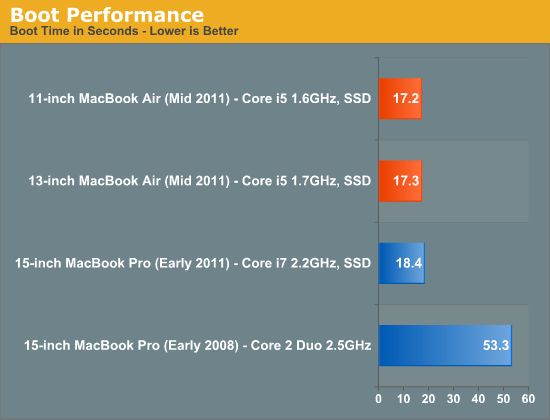
Boot time on these machines is great thanks to Apple's minimalist EFI and their SSDs. I will mention that the MacBook Air used to wake from sleep almost instantly however as of several OS revisions ago there seems to be a noticeable lag before I get a usable mouse cursor. I don't remember this being the case when the MacBook Air first came out and it's no different in Lion.
iMovie 11 Performance
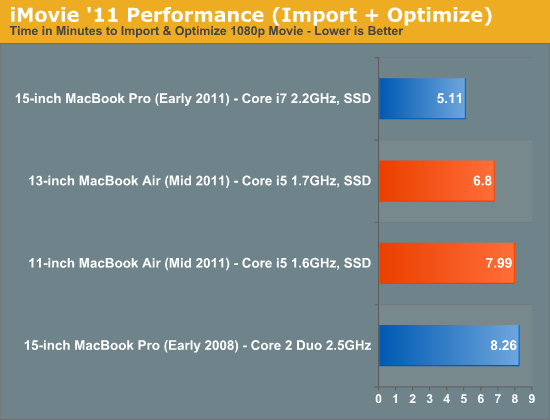
If you're going to be doing any video transcoding work you're going to want to upgrade the 11-inch MacBook Air's CPU. While it's much quicker than it used to be, the 1.6GHz Core i5 takes 17% longer to finish our iMovie import script than the 1.7GHz i5 in the 13-inch MacBook Air.
Exporting is a far bigger issue on these parts. Again the new systems are much faster than the old ones but if you're serious about video transcoding you should probably have a MacBook Pro.
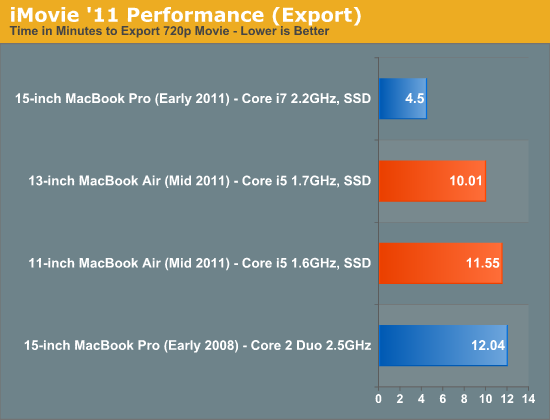
I'd also like to take this opportunity to say that it's absolutely ridiculous that Apple still doesn't support QuickSync in iMovie. We'd see far better performance from all Sandy Bridge equipped Macs if Apple would just take advantage of QuickSync. The silicon is there, it just needs to be used.
iPhoto 12MP RAW Import
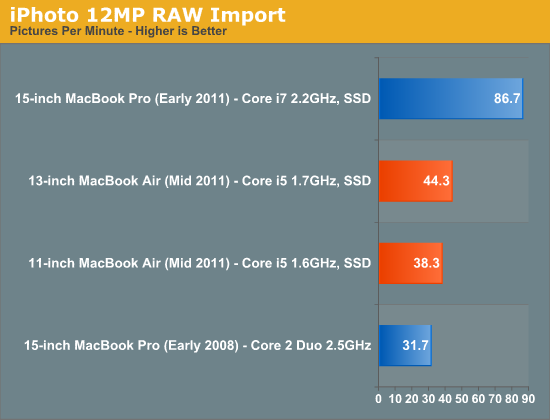
Here the new Airs do very well, but the 15-inch MacBook Pro is still around 2x the speed.
Adobe Lightroom 3
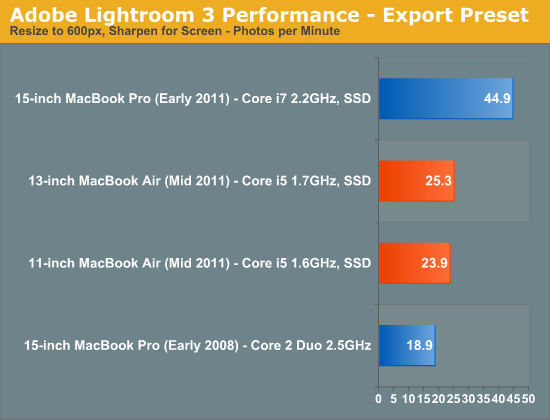
Final Cut Pro X
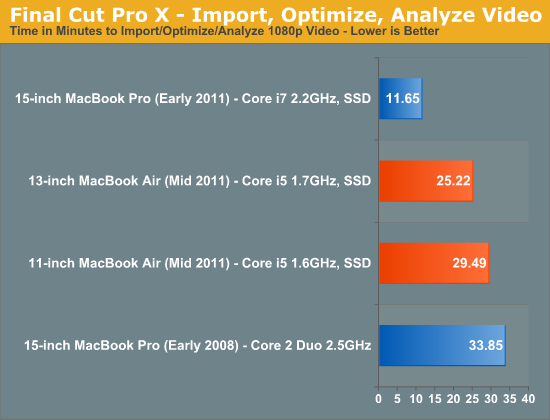
The trend continues. These new machines are faster than a 15-inch MacBook Pro from early 2008, but are no match for the new 2011 15-inch MacBook Pro. If you're going to do a lot of video encoding there's no replacement for more cores.










103 Comments
View All Comments
djpavcy - Thursday, July 28, 2011 - link
In your "2011 MacBook Air Lineup" table the "Cores/Threads" and "Base Clock Speed" categories are messed up.Excellent review btw
apinkel - Thursday, July 28, 2011 - link
Thanks for the review. I am very interested in the 13" MBA as it's the only ultraportable I can find that has what I consider to be the ideal resolution for a laptop display with good performance and battery life (the thinkpad x301 is a close second but there's too much of a performance sacrifce there although I prefer the ports and features on the x301).I need a windows machine... I'm just trying to find out if the MBA is a good windows only machine. I hear conflicting reports on this... I'm sure you guys are busy but if you find the time I'd love to hear your thoughts on using a MBA as windows only.
setzer - Thursday, July 28, 2011 - link
Hi Anand, you have a small typo on the specifications table:Base Clock Speed Intel HD 3000
check - Thursday, July 28, 2011 - link
From Page 4:http://www.anandtech.com/show/4528/the-2011-macboo...
"Apple has sold a USB 10/100 Ethernet dongle in the past for MacBook Air owners, but these days you can get better performance over good WiFi than you can from 100Mbps Ethernet"
I would like to see some testing that substantiates this claim.
In my experience traditional 802.11a/b/g/n can't sustain speeds anywhere near what a 100Mbit wired connection can do. Not to mention that if you are running WPA or any other encryption you take a substantial bandwidth hit.
JarredWalton - Thursday, July 28, 2011 - link
With a good router and WiFi card, and if you're in relatively close proximity to the router, 802.11n can definitely outperform 100Mbit Ethernet. If you're on the other side of the house, it will be slower, but then you'd have to run a 150 foot Ethernet cable. Now, Gigabit Ethernet is in a league of its own compared to WiFi, but we already knew that.Penti - Wednesday, August 10, 2011 - link
Just attach a 10GbE adapter to it then :) Thunderbolt does suppport this kind of expansion.Uritziel - Thursday, July 28, 2011 - link
It's not really necessary to substantiate a claim that an up-to-450Mbps standard "can get better performance" over a 100Mbps standard :\Silenus - Thursday, July 28, 2011 - link
Did you read the the rest of the review? This WAS tested. See the SSD and WiFi performance section:http://www.anandtech.com/show/4528/the-2011-macboo...
Both the 11 and 13 topped 116Mb transfers. 15 Macbook Pro and recent iMac did even better.
lyeoh - Thursday, July 28, 2011 - link
1) That's peak speed.2) That's probably for only one WiFi user with a good zero interference connection to the AP. Add another WiFi user (or ten ;) ) and the speed will drop.
Some (not all) APs also slow down everyone if a WiFi B/G user connects.
A5 - Thursday, July 28, 2011 - link
You're also not going to hit line speed on 100 Mbps networks without an optimal set of conditions. For everyday use (even with multiple users, etc), 802.11n is good enough and far easier to install a new network than 100 Mbps wired Ethernet.If you're doing a lot of the large file transfers or movie streaming, consider installing a Gigabit network though.